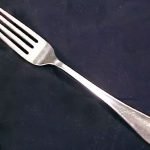Although the word fork dates back to about the eleventh century as the name of an implement used to pitch hay, the table fork was not used in England until 1611. It was then that a country squire named Thomas Coryate returned from a trip to Italy, where forks had been used since at least the eleventh century, bringing back with him the newfangled eating utensil and an enthusiasm for using it. Coryate’s countrymen, however, thought his zeal for eating with a fork was at best a foreign affectation and at worst an affront to God: he was mocked on the stage for his effete reluctance to touch his food with his hands, and he was castigated in churches for putting a devilish fork between himself and the food that his Lord so graciously gave him. Perhaps, however, much of this uproar was merely sour grapes, since it was evident that Coryate, unlike everyone else in England, was now able to eat a meal without smearing it all over his hands, clothes, and table cloth. In time, therefore, reason prevailed and the dinner fork did catch on in England. In origin, the word fork derives from the Latin furca, meaning a two-pronged fork; the diminutive otfurca—furcula, meaning little fork—was adopted by ornithologists as the anatomical name for what everyone else calls a wishbone.
An elongated instrument that splits at the end to form two or more prongs.

